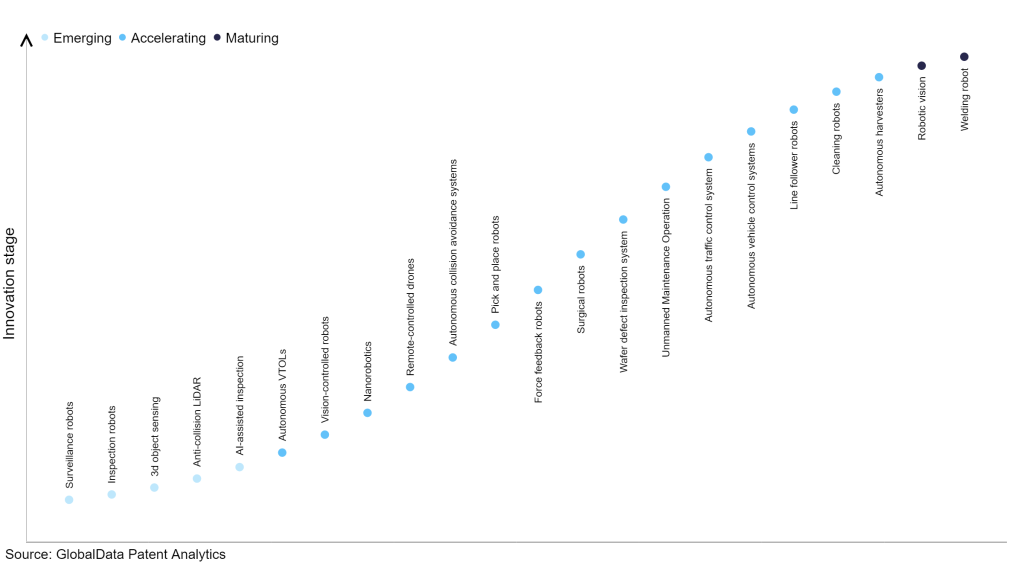The technology industry continues to be a hotbed of innovation, with advancements in robotics, machine learning, artificial intelligence (AI), and sensor technologies, and growing importance of technologies such as robotic arm, welding power source, welding torch/tooling, and vision systems. These technologies work together to enable precise and efficient automated welding operations. In the last three years alone, there have been over 3.6 million patents filed and granted in the technology industry, according to GlobalData’s report on Innovation in Robotics: Welding robot. Buy the report here.
However, not all innovations are equal and nor do they follow a constant upward trend. Instead, their evolution takes the form of an S-shaped curve that reflects their typical lifecycle from early emergence to accelerating adoption, before finally stabilising and reaching maturity.
Identifying where a particular innovation is on this journey, especially those that are in the emerging and accelerating stages, is essential for understanding their current level of adoption and the likely future trajectory and impact they will have.
300+ innovations will shape the technology industry
According to GlobalData’s Technology Foresights, which plots the S-curve for the technology industry using innovation intensity models built on over 2.5 million patents, there are 300+ innovation areas that will shape the future of the industry.
Within the emerging innovation stage, AI-assisted inspection, anti-collision LiDAR, and 3D object sensing are disruptive technologies that are in the early stages of application and should be tracked closely. Autonomous harvesters, cleaning robots, and line follower robots are some of the accelerating innovation areas, where adoption has been steadily increasing. Among maturing innovation areas are, welding robot and robotic vision, which are now well established in the industry.
Innovation S-curve for robotics in the technology industry

Welding robot is a key innovation area in robotics
Welding robots are robotic systems specifically designed for automated welding tasks. They find widespread application in manufacturing environments where their precision and efficiency are utilised to weld components together swiftly and accurately. These robots are programmable and capable of executing various welding techniques, including arc welding, gas welding, and spot welding.
GlobalData’s analysis also uncovers the companies at the forefront of each innovation area and assesses the potential reach and impact of their patenting activity across different applications and geographies. According to GlobalData, there are 60+ companies, spanning technology vendors, established technology companies, and up-and-coming start-ups engaged in the development and application of welding robot.
Key players in welding robot – a disruptive innovation in the technology industry
‘Application diversity’ measures the number of different applications identified for each relevant patent and broadly splits companies into either ‘niche’ or ‘diversified’ innovators.
‘Geographic reach’ refers to the number of different countries each relevant patent is registered in and reflects the breadth of geographic application intended, ranging from ‘global’ to ‘local’.
Patent volumes related to welding robot
Source: GlobalData Patent Analytics
Trumpf is one of the leading patent filers in welding robot. The company’s patents are aimed at a method and a machine tool for processing workpiece, comprising a workpiece movement device and a workpiece support that supports both a workpiece during a processing operation and a workpiece remainder produced from the workpiece during the processing operation.
The workpiece support comprises a first support portion and an additional support portion. The first support portion comprises a loading-side support portion arranged in a loading region of the machine tool, with the additional support portion arranged to move relative to the loading-side support portion between the loading region and an unloading region of the machine tool. The unloading region is offset in a horizontal direction from the loading region, wherein the loading-side support portion is arranged to move in a vertical direction between a loading level and a bypass level located above or below the loading level.
Other prominent patent filers in the space include Kobe Steel and Enovis.
By geographic reach, Wobben Properties leads the pack, followed by STIWA and Boeing. In terms of application diversity, Thyssenkrupp Drauz Nothelfer holds the top position, followed by Robert Bosch Stiftung and Midea.
Welding robots provide benefits such as increased productivity, improved weld quality, reduced cycle times, and enhanced worker safety. They are widely used in industries such as automotive manufacturing, aerospace, construction, and metal fabrication, where repetitive and high-precision welding is required.
To further understand how robotics is disrupting the technology industry, access GlobalData’s latest thematic research report on Robotics – Thematic Research Report.
Data Insights
From

The gold standard of business intelligence.
Blending expert knowledge with cutting-edge technology, GlobalData’s unrivalled proprietary data will enable you to decode what’s happening in your market. You can make better informed decisions and gain a future-proof advantage over your competitors.







